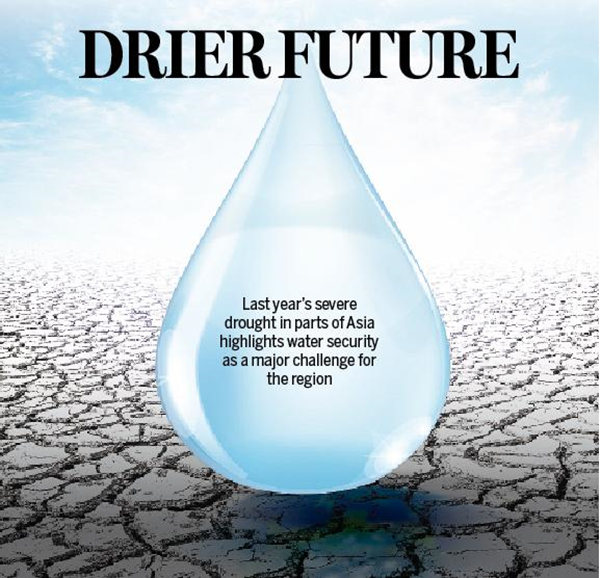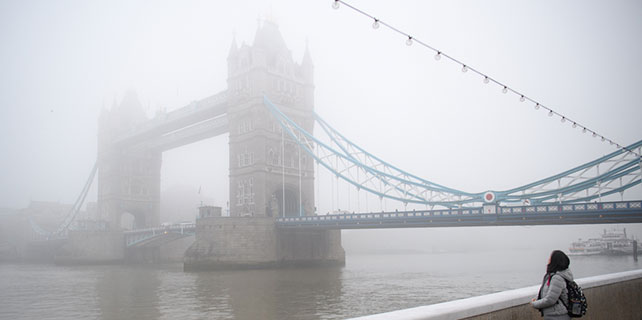Drier future

Southeast Asia has just experienced some of its worst droughts in living memory, with analysts warning that the combination of economic and population growth plus climate change is starting to have a profound impact on water security and agriculture.
A number of recent reports, all from credible international organizations, see a potential water crisis looming in the wider region.
Asia and the Pacific is a "global hot spot for water insecurity", the Asian Development Bank said in its Asian Water Development Outlook 2016: Strengthening Water Security in Asia and the Pacific.
A major study by the Massachusetts Institute of Technology last year said "economic and population growth on top of climate change could lead to serious water shortages across a broad swath of Asia by 2050".
The institute's Asia case study, entitled Projections of Water Stress Based on an Ensemble of Socioeconomic Growth and Climate Change Scenarios, warned that by the middle of the century, the region, where roughly half the world's population lives, could face "severe water stress".
In other words, billions of people will have a lot less water than they do today.
Asia's Next Challenge: Securing the Region's Water Future, a report by the Asia Society's Leadership Group on Water Security in Asia, said the decreased access to a "safe, stable water supply in Asia will have a profound impact on security throughout the region".
These warnings come as many parts of Asia experienced some of the worst drought conditions in decades last year.
Large parts of Thailand and Myanmar saw dams at less than 10 percent capacity, while Vietnam experienced its worst drought in a century, with 52 out of its 63 provinces affected by drought and a state of emergency declared in 18 of them.
"Coupled with the droughts' impacts, saltwater intrusion has extended up to 90 km inland in some (Vietnam) coastal areas, leaving river water too salty for human or animal consumption, or to irrigate crops and continue fish-farming production," the Food and Agriculture Organization of the United Nations (FAO) reported in August.
"The Asia-Pacific region is a global hot spot for water insecurity," said Yasmin Siddiqi, principal water resources specialist with the Manila-based Asian Development Bank's Sustainable Development and Climate Change Department.
"It remains home to 60 percent of the world's population and half of the world's poorest people," she told China Daily.
Water for agriculture continues to consume 80 percent of the region's resources and 1.7 billion people lack access to basic sanitation.
Siddiqi said that by 2030, the region will have 22 megacities —cities with more than 10 million people — placing enormous stress on water resources.
"Recent estimates indicate up to 3.4 billion people could be living in water-stressed areas of Asia by 2050," she said.
Coupling demographics with changes in demand adds a further dimension to an already growing problem.
Industrialization and economic transformation require more power and a shift to more water-intensive diets, increasing competition between water users like industry and agriculture.
The region's water demand is projected to increase by about 55 percent, due to the growing needs for domestic water, manufacturing, and thermal electricity generation.
Agriculture will need to produce 60 percent more food globally by 2050, and 100 percent more in developing countries.
Analysts say population growth and economic development are the main drivers that will determine Asia's water future.
"Generally, Asian countries with the highest population growth will have the lowest per capita water availability, the key determinant of water stress," Siddiqi said.
"Climate change will have a negative impact on total available water resources and increase the severity and frequency of floods and drought. Drought will be more severe over most of Asia."
She said the next few decades will see an "intensification of multiple challenges at the nexus of water, food and energy".
According to the ADB report, 1.7 billion people in Asia and the Pacific lack access to basic sanitation and the region has now become a "global hot spot for water insecurity".
Recent estimates suggest that by 2050, 3.4 billion of the region's people could be living in water-stressed areas, and water demand will increase by 55 percent.
While the rural population is likely to remain constant, Asian urban areas are expected to grow by 60 percent, analysts say.
Li He, natural resources officer at the FAO's Regional Office for Asia and the Pacific in Bangkok, said: "Asia freshwater availability is less than half of the global annual average per capita. And the uneven distribution also causes the physical water scarcity."
She said studies have shown that parts of Asia's monsoon region are now becoming arid due to climate change. In some regions, annual precipitation and runoff has decreased by about 12.1 percent and 27.3 percent, respectively, while the annual average temperature has increased about 0.5 C.
Climate change is having an impact, with droughts becoming more frequent and more severe, "not only because of the decrease of the precipitation, but also the change of the rainfall pattern: More heavy rains, fewer light rains and moderate rains", she told China Daily.
Asia's population density also adds to the region's water problems.
"The Asia Pacific region is home to 60 percent of the world's population but it has only 36 percent of its water resources," Li said.
"Per capita water availability is half of the world average. And it is expected that 1 billion people (half the global increase) will be added to the region's population by 2050.
"Along with the GDP growth, agriculture's share of GDP is declining. Competition with other sectors for water became more severe."
Asia has "diversified water scarcity problems", Li said, with population density among the causes. She also cited water governance, water conflicts between sectors, and uneven distribution (seasonal, spatial and the precipitation pattern) as contributing factors.
In terms of landmass and population, Asia dominates the rest of the globe, according to an MIT study.
"But at least 1 billion of the continent's estimated 4.4 billion people could be facing extreme freshwater shortages in the near future," researchers said in a study published last year in the journal PLOS ONE.
If current trends in climate change and population growth continues, models show that a big swath of Asia could face a "high risk of severe water stress" — meaning water systems will be overtaxed relative to the number of people they serve — in as little as 35 years.
"It's not just a climate change issue," Adam Schlosser, one of the paper's co-authors, said when the report was released.
"We simply cannot ignore that economic and population growth in society can have a very strong influence on our demand for resources."
The United Nations, in its World Water Development Report, has warned that within the next 15 years the world water supply will fall short by at least 40 percent and cited Southeast Asia and Sub-Saharan Africa as two critical regions.
The report said a handful of factors are working in concert to constrict the already contested water supply in developing countries: Unchecked population growth, urbanization and industrialization.
"Unless the balance between demand and finite supplies is restored, the world will face an increasingly severe global water deficit," the report said.
It also warned that population growth has become another significant factor in water security. The UN's projection is for a global population of 9.1 billion people by 2050.
















